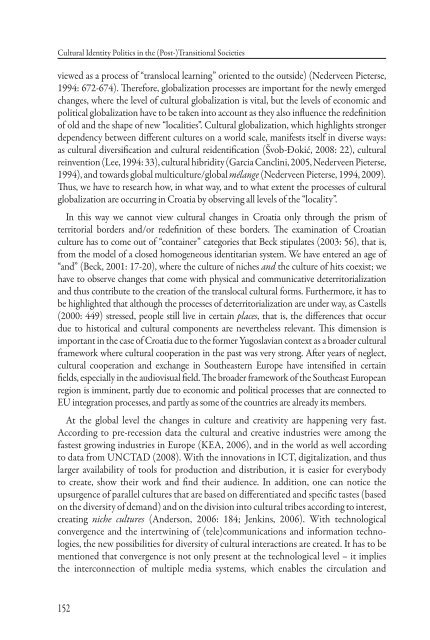Cultural Identity Politics in the (Post-)Transitional Societies
Cultural Identity Politics in the (Post-)Transitional Societies
Cultural Identity Politics in the (Post-)Transitional Societies
You also want an ePaper? Increase the reach of your titles
YUMPU automatically turns print PDFs into web optimized ePapers that Google loves.
<strong>Cultural</strong> <strong>Identity</strong> <strong>Politics</strong> <strong>in</strong> <strong>the</strong> (<strong>Post</strong>-)<strong>Transitional</strong> <strong>Societies</strong><br />
viewed as a process of “translocal learn<strong>in</strong>g” oriented to <strong>the</strong> outside) (Nederveen Pieterse,<br />
1994: 672-674). Therefore, globalization processes are important for <strong>the</strong> newly emerged<br />
changes, where <strong>the</strong> level of cultural globalization is vital, but <strong>the</strong> levels of economic and<br />
political globalization have to be taken <strong>in</strong>to account as <strong>the</strong>y also <strong>in</strong>fluence <strong>the</strong> redef<strong>in</strong>ition<br />
of old and <strong>the</strong> shape of new “localities”. <strong>Cultural</strong> globalization, which highlights stronger<br />
dependency between different cultures on a world scale, manifests itself <strong>in</strong> diverse ways:<br />
as cultural diversification and cultural reidentification (Švob-Đokić, 2008: 22), cultural<br />
re<strong>in</strong>vention (Lee, 1994: 33), cultural hibridity (Garcia Cancl<strong>in</strong>i, 2005, Nederveen Pieterse,<br />
1994), and towards global multiculture/global mélange (Nederveen Pieterse, 1994, 2009).<br />
Thus, we have to research how, <strong>in</strong> what way, and to what extent <strong>the</strong> processes of cultural<br />
globalization are occurr<strong>in</strong>g <strong>in</strong> Croatia by observ<strong>in</strong>g all levels of <strong>the</strong> “locality”.<br />
In this way we cannot view cultural changes <strong>in</strong> Croatia only through <strong>the</strong> prism of<br />
territorial borders and/or redef<strong>in</strong>ition of <strong>the</strong>se borders. The exam<strong>in</strong>ation of Croatian<br />
culture has to come out of “conta<strong>in</strong>er” categories that Beck stipulates (2003: 56), that is,<br />
from <strong>the</strong> model of a closed homogeneous identitarian system. We have entered an age of<br />
“and” (Beck, 2001: 17-20), where <strong>the</strong> culture of niches and <strong>the</strong> culture of hits coexist; we<br />
have to observe changes that come with physical and communicative deterritorialization<br />
and thus contribute to <strong>the</strong> creation of <strong>the</strong> translocal cultural forms. Fur<strong>the</strong>rmore, it has to<br />
be highlighted that although <strong>the</strong> processes of deterritorialization are under way, as Castells<br />
(2000: 449) stressed, people still live <strong>in</strong> certa<strong>in</strong> places, that is, <strong>the</strong> differences that occur<br />
due to historical and cultural components are never<strong>the</strong>less relevant. This dimension is<br />
important <strong>in</strong> <strong>the</strong> case of Croatia due to <strong>the</strong> former Yugoslavian context as a broader cultural<br />
framework where cultural cooperation <strong>in</strong> <strong>the</strong> past was very strong. After years of neglect,<br />
cultural cooperation and exchange <strong>in</strong> Sou<strong>the</strong>astern Europe have <strong>in</strong>tensified <strong>in</strong> certa<strong>in</strong><br />
fields, especially <strong>in</strong> <strong>the</strong> audiovisual field. The broader framework of <strong>the</strong> Sou<strong>the</strong>ast European<br />
region is imm<strong>in</strong>ent, partly due to economic and political processes that are connected to<br />
EU <strong>in</strong>tegration processes, and partly as some of <strong>the</strong> countries are already its members.<br />
At <strong>the</strong> global level <strong>the</strong> changes <strong>in</strong> culture and creativity are happen<strong>in</strong>g very fast.<br />
Accord<strong>in</strong>g to pre-recession data <strong>the</strong> cultural and creative <strong>in</strong>dustries were among <strong>the</strong><br />
fastest grow<strong>in</strong>g <strong>in</strong>dustries <strong>in</strong> Europe (KEA, 2006), and <strong>in</strong> <strong>the</strong> world as well accord<strong>in</strong>g<br />
to data from UNCTAD (2008). With <strong>the</strong> <strong>in</strong>novations <strong>in</strong> ICT, digitalization, and thus<br />
larger availability of tools for production and distribution, it is easier for everybody<br />
to create, show <strong>the</strong>ir work and f<strong>in</strong>d <strong>the</strong>ir audience. In addition, one can notice <strong>the</strong><br />
upsurgence of parallel cultures that are based on differentiated and specific tastes (based<br />
on <strong>the</strong> diversity of demand) and on <strong>the</strong> division <strong>in</strong>to cultural tribes accord<strong>in</strong>g to <strong>in</strong>terest,<br />
creat<strong>in</strong>g niche cultures (Anderson, 2006: 184; Jenk<strong>in</strong>s, 2006). With technological<br />
convergence and <strong>the</strong> <strong>in</strong>tertw<strong>in</strong><strong>in</strong>g of (tele)communications and <strong>in</strong>formation technologies,<br />
<strong>the</strong> new possibilities for diversity of cultural <strong>in</strong>teractions are created. It has to be<br />
mentioned that convergence is not only present at <strong>the</strong> technological level – it implies<br />
<strong>the</strong> <strong>in</strong>terconnection of multiple media systems, which enables <strong>the</strong> circulation and<br />
152




